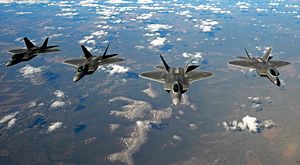This Wednesday, a formation of F-22 Raptors, the U.S. Air Force’s newest fighter aircraft, flew at low altitude over U.S. Forces Korea’s Osan Air Base in Gyeonggi Province, about 48 kilometers south of Seoul, Yonhap News reports.
The overflight of the F-22 Raptor formation is part of a continuing show of force of both South Korea and the United States after North Korea conducted its fourth nuclear test on January 6 and launched a so-called earth observation satellite on February 7 in defiance of United Nations Security Council resolutions.
The four F-22 Raptors were escorted by four F-15K Slam Eagle fighter jets from the Republic of Korea Air Force and four F-16 Fighting Falcons dispatched by U.S. Forces Korea. After the low-level overflight, the four F-22 landed at Osan Air Base. Two of the aircraft will remain in South Korea “for a while,” according to military sources interviewed by Yonhap News, whereas the other two will return to their home base, Kadena Air base in Okinawa, Japan. In the event of a crisis F-22 stealth fighters could be deployed to the Korean Peninsula within two hours.
“The F-22 Raptor is the most capable air superiority fighter in the world and it represents one of many capabilities available for the defense of this great nation,” Lieutenant General Terrence O’Shaughnessy, deputy commander of U.S. Forces Korea and the commander of the 7th Air Force, told reporters on Wednesday. “The U.S. maintains an ironclad commitment to the defense of the Republic of Korea.”
According to the U.S. Air Force website:
The F-22 has a significant capability to attack surface targets. In the air-to-ground configuration the aircraft can carry two 1,000-pound GBU-32 Joint Direct Attack Munitions internally and will use on-board avionics for navigation and weapons delivery support. In the future air-to-ground capability will be enhanced with the addition of an upgraded radar and up to eight small diameter bombs.
On January 9, a B-52 bomber from Andersen Air Force base in Guam flew over South Korea in response to the nuclear test (See: “US Sends B-52 Bomber Over South Korea in Response to Pyongyang’s Nuclear Test”). Last week, U.S. Forces Korea also announced the deployment of a Patriot surface-to-air missile battery to deter North Korean missile attacks, and the U.S. military will also likely station MQ-1C Gray Eagle drones on the Korean peninsula in the near future.
Furthermore, “in response to the evolving threat posed by North Korea, the United States and the Republic of Korea [ROK] have made an Alliance decision to begin formal consultations regarding improvements to the Alliance missile defense posture, specifically the viability of a Terminal High-Altitude Area Defense (THAAD) system operated by U.S. Forces Korea,” a joint ROK-U.S. press release from February 7 stated.
The upcoming joint ROK-U.S. military drills, Key Resolve and Foal Eagle, to be held for eight weeks in March and April 2016, will be the largest ever, according to South Korean government officials.

































